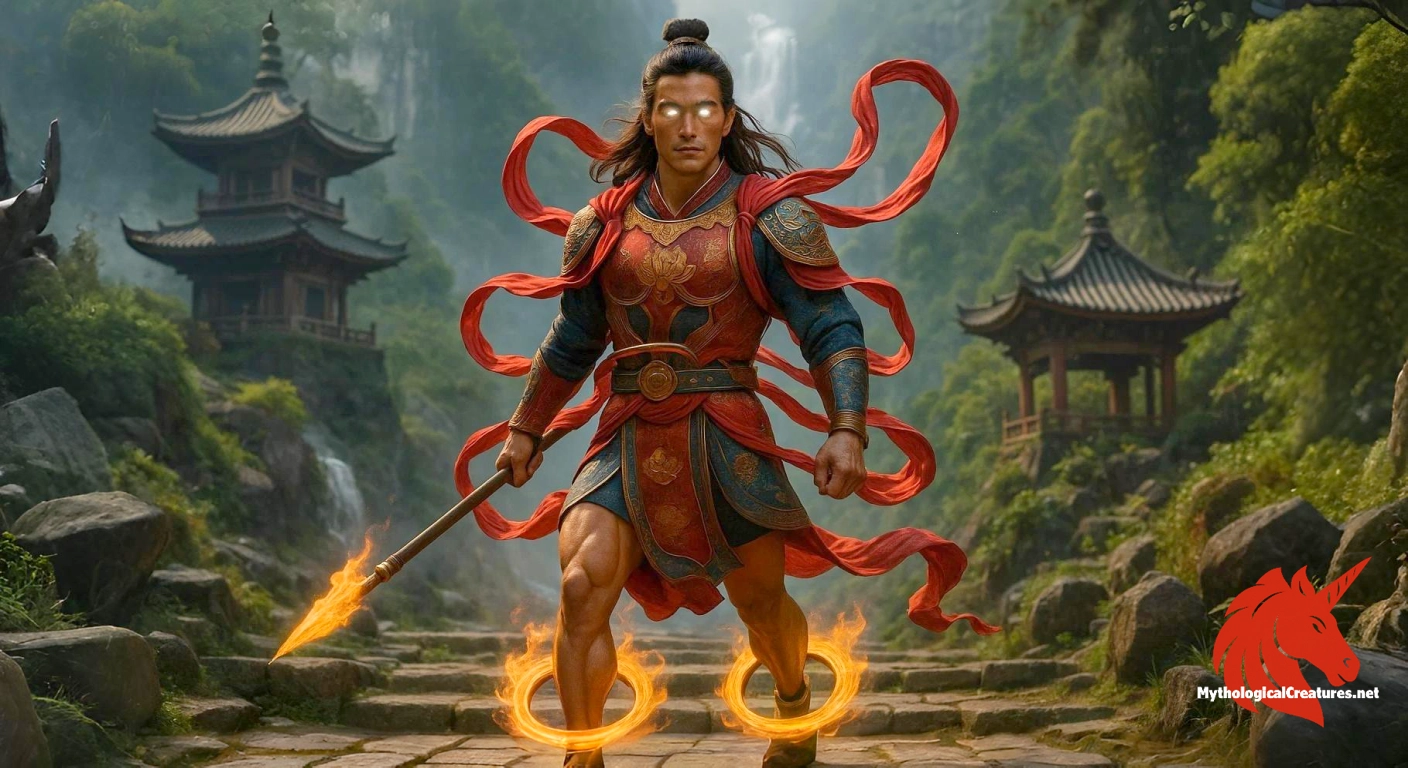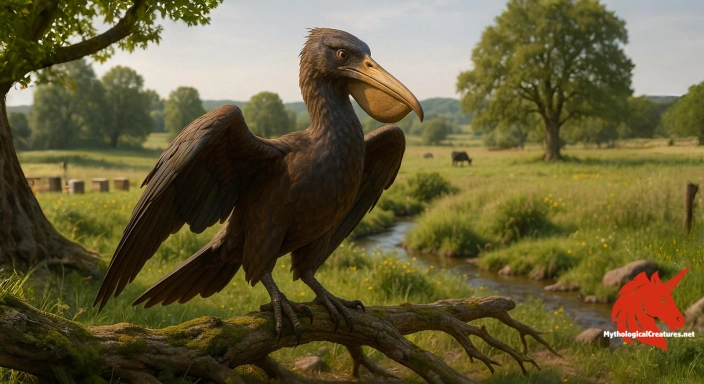Nezha: Nezha is a celebrated protection deity in Chinese mythology, revered across Buddhism, Taoism, and Chinese folk religion.

Nezha
Nezha - Nezha is celebrated for his defiance against evil, symbolising youthful rebellion and the triumph of justice.
Origins & First Encounters
Nezha is a dynamic and revered protector deity whose story weaves together elements from Chinese Buddhism, Confucianism, Taoism, and Chinese folk religion. His origins are steeped in ancient myth, with early attestations highlighting his role as a fierce guardian and youthful warrior against malevolent forces. Born into a world of divine conflict, he is often celebrated for his extraordinary birth and subsequent transformation into an immortal protector. His official Taoist title, Marshal of the Central Altar, underscores his high status within the celestial hierarchy. Nezha’s epithet as the Third Lotus Prince reflects his association with purity and rebirth, symbolised by the lotus flower often linked to divine creation. The cultural context surrounding his narrative blends martial prowess with moral defiance, resonating with audiences who value both bravery and a rebellious spirit. His legend intertwines spiritual symbolism with the heroics of youthful vigour, making him an enduring figure in Chinese mythology. Throughout the centuries, his story has symbolised hope and the triumph of righteousness over evil, securing his legacy in both ancient texts and contemporary culture.
Source Texts & Tale Variants
The textual history of Nezha is rich, drawing from a variety of ancient narratives and folklore traditions. Early literary works such as the Ming dynasty epic 'Fengshen Yanyi' are among the most celebrated sources that recount his heroic deeds and mystical origins. Multiple Buddhist and Taoist scriptures also include accounts of his miraculous birth and subsequent rise as a divine warrior. Oral traditions and regional operas have further enriched his mythos, often presenting alternative versions of his legendary battles and divine interventions. Some narratives focus on his defiance against oppressive forces, while others highlight his self-sacrifice for the greater good. The diversity of his sources illustrates the dynamic interplay between written records and folk traditions in Chinese mythology. Varying storylines offer subtle differences in his characterisation, ranging from a rebellious child-saviour to a wise and powerful deity. Consequently, Nezha’s story has been fluid, adapting over time to suit the spiritual and cultural needs of different communities.
Form & Powers
Nezha is frequently portrayed as a youthful and striking figure whose physical presence exudes both grace and formidable strength. His appearance is often characterised by vibrant red attire, symbolising vitality, courage, and a fiery spirit. He is depicted with a lithe, athletic build that conveys both the innocence of youth and the robustness of a seasoned warrior. Iconography commonly includes his legendary armaments, such as the fire-tipped spear and the wind fire wheels, which add to his dynamic image on the battlefield. His facial features are typically rendered with intense eyes that capture his determination and deep sense of purpose. Artistic representations sometimes infuse celestial motifs, such as a luminous halo or ethereal glow, suggesting his divine origin and supernatural powers. Variations in depictions may highlight additional elements like ornate helmets or celestial vestments, each enhancing his heroic stature. These detailed physical descriptions serve to reinforce the idea of Nezha as an extraordinary blend of mortal resilience and divine energy.
Regional Faces
The myth of Nezha has inspired a range of regional adaptations and interpretations throughout China and beyond. In northern regions, depictions of Nezha tend to emphasise his martial qualities and his role as an avenger, resonating with local historical narratives of resistance. Southern traditions often focus on his protective nature, portraying him as a benevolent guardian who defends communities from misfortune. In some areas, his birth story is interwoven with local legends involving natural phenomena and auspicious omens, thus enhancing the regional flavour of his narrative. Taiwanese portrayals may integrate unique cultural symbols, reflecting island-specific spiritual beliefs and artistic sensibilities. Local operas and festivals celebrate his dynamic presence, transforming his myth into a vital part of community rituals. These varying accounts highlight the flexibility of his character, allowing communities to adapt his symbolic role to address local challenges. As a result, regional variations of Nezha serve as a reminder of the enduring and adaptable nature of myth in the face of cultural diversity.
Cultural Parallels
Nezha shares a remarkable set of traits with several other heroic figures across different mythologies, highlighting universal themes of youth, rebellion, and divine justice. His narrative of overcoming fate and battling oppressive deities mirrors the journeys of other courageous gods like the Indian deity Kartikeya, who similarly exhibits youthful energy and martial prowess. Both figures inspire admiration for their defiance against cosmic challenges while symbolising the triumph of inner strength over external adversity. In some Western traditions, one might loosely compare his character to that of a youthful Hercules, whose legendary feats similarly transcend mortal limitations. Cross-cultural parallels also emerge in his role as a protector of the innocent, a theme that resonates with mythic heroes in numerous societies. The shared motifs of resurrection, self-sacrifice, and moral defiance further solidify these comparative links. Such universal comparisons invite a broader understanding of how diverse cultures use myth to explore complex ideas about destiny, power, and justice. Through these similarities, Nezha’s myth ultimately contributes to a global dialogue on the archetype of the rebellious young warrior.
Legacy & Modern Evolution
Throughout history, the depiction of Nezha has evolved from ancient myth to a vibrant icon in modern media and popular culture. His legacy is marked by a continual reinvention that respects traditional narratives while embracing contemporary themes of resistance and empowerment. Modern film and animation have breathed new life into his story, most notably in recent animated films that recast him as a symbol of youthful defiance and the struggle against oppressive systems. This evolutionary process reflects a broader societal fascination with characters who challenge conventional authority and embrace their individuality. His image is frequently invoked in political and cultural debates, representing the perpetual conflict between heritage and modernity. Contemporary literature and art have also drawn inspiration from his myth, adapting his story to reflect current social and ethical dilemmas. The enduring appeal of Nezha lies in his ability to transcend the boundaries of time, appealing to successive generations with his timeless journey. His legacy reinforces the power of myth to inspire, transform, and adapt, ensuring that his story remains a central thread in the tapestry of cultural identity.
Interesting Fact
One notable aspect of Nezha's myth is his unconventional birth and subsequent deification, which has inspired various adaptations in modern media.
Quick Creature Info
Associations:
Our Mythic Legendary Rating:

Also Sometimes Known As:
Habitat:
Supernatural Powers:
Physical Attributes:
Abilities:
Behavior:
Lore:
Related Creatures, Tales or Lore
- SSun Wukong
- EErlang Shen
- GGuanyin
References
Discover Another Mythical Legend You May Not Have Heard Of?
Uncover the mysteries of ancient folklore and expand your knowledge of legendary beings from cultures around the world.
Dare to Meet the Cikavac....
Mythical Disclaimer: The images and data on this site are derived from various historical and literary sources, but we have found that many myths often have multiple versions and interpretations across references, sometimes contradictory. As a result, these creature depictions are artistic interpretations—imaginative blends of folklore, legend, and a dash of AI guesswork. Because creature descriptions vary widely, our illustrations and accompanying information represent our best effort to honor mythology while bridging creative gaps. Enjoy these interpretations—just remember, we've done our best to respect the stories and validate available data, but in the realm of mythology, details often shift, imagination leads the way, and nothing is ever set in stone!
Curated by the Mythological Creatures Team (rev. May 2025)
